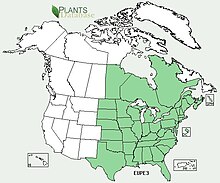| Eupatorium perfoliatum | |
|---|---|

| |
| Conservation status | |
 Secure (NatureServe) | |
| Scientific classification | |
| Kingdom: | Plantae |
| Clade: | Tracheophytes |
| Clade: | Angiosperms |
| Clade: | Eudicots |
| Clade: | Asterids |
| Order: | Asterales |
| Family: | Asteraceae |
| Genus: | Eupatorium |
| Species: | E. perfoliatum |
| Binomial name | |
| Eupatorium perfoliatum L. | |

| |
| Synonyms | |
Synonymy
| |
Eupatorium perfoliatum, known as common boneset or just boneset, is a North American perennial plant in the family Asteraceae. It is a common native to the Eastern United States and Canada, widespread from Nova Scotia to Florida, west as far as Texas, Nebraska, the Dakotas, and Manitoba. It is also called agueweed, feverwort, or sweating-plant. In herbal medicine, the plant is a diaphoretic, or an agent to cause sweating. It was introduced to American colonists by natives who used the plant for breaking fevers by means of heavy sweating, and commonly used to treat fever by the African-American population of the southern United States. The name "boneset" comes from the use of the plant to treat dengue fever, which is also called "break-bone fever." It is nearly always found in low, wet areas.
Description

Eupatorium perfoliatum grows up to 100 cm (39 inches) tall, with opposite, serrate leaves that clasp the stems (perfoliate). The stem is hairy. The plant produces dense clusters of tiny white flower heads held above the foliage. In Illinois, the plant blooms during late summer and early fall. Its native habitats include damp prairies, bogs, and alluvial woods.
Eupatorium perfoliatum can form hybrids with other species of the genus Eupatorium, for example Eupatorium serotinum.
Phytochemistry and safety
Eupatorium perfoliatum leaves and roots contain mixed phytochemicals, including polysaccharides (containing xylose and glucuronic acid), tannins, volatile oil, sesquiterpene lactones, sterols, triterpenes, alkaloids, and various flavonoids, such as quercetin, kaempferol, and caffeic acid derivatives. E. perfoliatum and several of its related species are listed on the Poisonous Plants Database of the US Food and Drug Administration, with E. perfoliatum described as an "unapproved homeopathic medicine" with unknown safety by the US National Library of Medicine.
Holistic health companies marketing fraudulent supplement products that contained E. perforliatum with claims of benefit against COVID-19 were warned by the US Food and Drug Administration in 2020 about making illegal health claims and scamming consumers from their money.
Traditional medicine
Eupatorium perfoliatum (also called boneset) was used in traditional medicine by Native Americans who applied extracts for fever and common colds. By the early 20th century, it was reported as commonly used by rural African-Americans in the Deep South to treat fever, including dengue fever, though it was considered less effective for yellow fever and typhoid fever. Possible effects of E. perfoliatum for these uses remain undefined by adequate scientific research, and are unconfirmed by high-quality clinical research. If consumed in large amounts, tea made from its leaves may cause diarrhea.
References
- "Eupatorium perfoliatum". NatureServe Explorer. NatureServe. Retrieved 2023-12-20.
- "Eupatorium perfoliatum L.". The Global Compositae Checklist (GCC) – via The Plant List. Note that this website has been superseded by World Flora Online
- ^ Siripun, Kunsiri Chaw; Schilling, Edward E. (2006). "Eupatorium perfoliatum". In Flora of North America Editorial Committee (ed.). Flora of North America North of Mexico (FNA). Vol. 21. New York and Oxford: Oxford University Press – via eFloras.org, Missouri Botanical Garden, St. Louis, MO & Harvard University Herbaria, Cambridge, MA.
- "Eupatorium perfoliatum". County-level distribution map from the North American Plant Atlas (NAPA). Biota of North America Program (BONAP). 2014.
- ^ Griffith, Lawrence D. (2008). Flowers and Herbs of Early America. The Colonial Williamsburg Foundation. p. 158.
- ^ Hilty, John (24 October 2018). "Common Boneset". Illinois Wildflowers. Retrieved 6 September 2022.
- "Lady Bird Johnson Wildflower Center - The University of Texas at Austin". www.wildflower.org. Retrieved 2023-01-29.
- ^ "Boneset (Eupatorium perfoliatum L.) Uses, Benefits and Dosage". Drugs.com. 1 February 2019. Retrieved 4 March 2019.
- ^ Hensel, Andreas; Maas, Mareike; Sendker, Jandirk; Lechtenberg, Matthias; Petereit, Frank; Deters, Alexandra; Schmidt, Thomas; Stark, Timo (2011). "Eupatorium perfoliatum L.: Phytochemistry, traditional use and current applications". Journal of Ethnopharmacology. 138 (3): 641–651. doi:10.1016/j.jep.2011.10.002. PMID 22004891.
- "Flavonol-3-glucosides in 8 Eupatorium species; In: FDA Poisonous Plant Database". US Food and Drug Administration. 2019. Retrieved 4 March 2019.
- "Eupatorium perfoliatum L." DailyMed, National Library of Medicine, US National Institutes of Health. 2019. Retrieved 4 March 2019.
- "Fraudulent Coronavirus Disease 2019 (COVID-19) Products". US Food and Drug Administration. 7 April 2020. Retrieved 8 April 2020.
External links
 Media related to Eupatorium perfoliatum at Wikimedia Commons
Media related to Eupatorium perfoliatum at Wikimedia Commons
| Taxon identifiers | |
|---|---|
| Eupatorium perfoliatum |
|